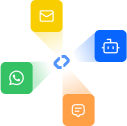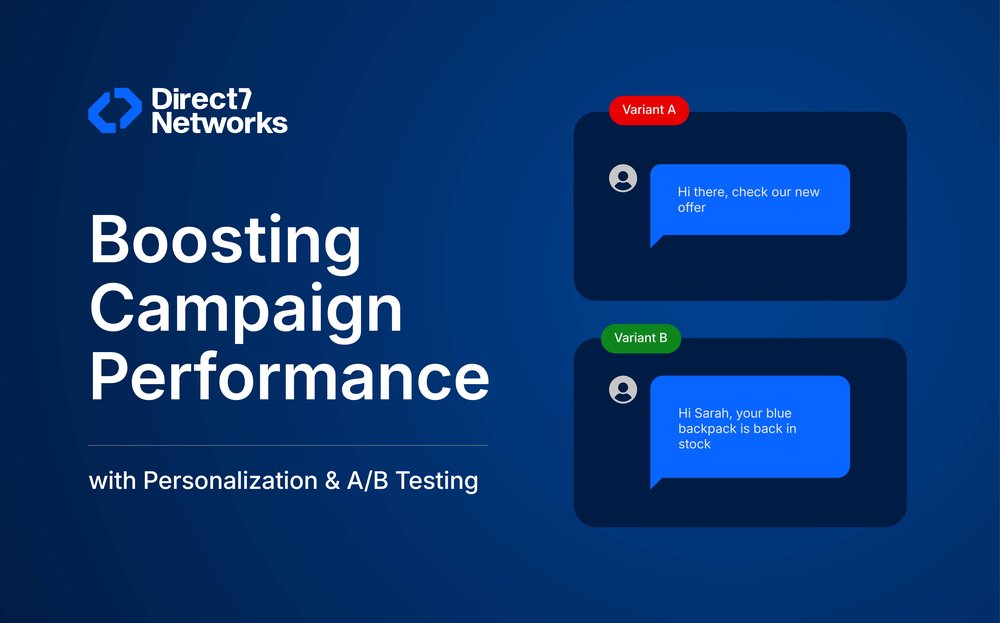People engage most with messages that feel truly relevant—and with offers that are proven through testing rather than guesswork. By combining personalization with A/B testing, you build a repeatable system that consistently boosts opens, clicks, and revenue while minimizing wasted budget.
This guide explains how to do it step by step: what data you need, which tests matter, how to read results, and the pitfalls to avoid. The approach applies across SMS, WhatsApp channels, email, push, and in-app messages.
I. Start with First Principles
Every high-performing messaging program runs on three simple truths:
- Relevance beats volume → Sending fewer, well-targeted messages works better than blasting more messages at random. Match content to the recipient’s need, timing, and channel.
- Proof beats opinion → Don’t guess. Run clean tests (one change at a time), measure impact, and make decisions based on results—not gut feeling.
- Respect beats shortcuts → Always:
- Collect consent.
- Honor opt-outs.
- Avoid including sensitive personal data in messages.
Takeaway: If you only focus on relevance, clean testing, and respectful practices, you’ll see steady performance gains over time.
II. The Data You Actually Need
You don’t need a perfect 360° customer profile to begin. Effective personalization can be built on a short, clean dataset:
- Identity → Country, language, time zone.
- Engagement → Last open/click, last visit, last purchase.
- Commerce → Last product or category viewed, items in cart, order value band.
- Preferences → Chosen channels (SMS, WhatsApp, email) and topics of interest.
- Real-Time Context → Device type, session activity, inventory flags.
Keep the Data Pipeline Simple
- Collect explicit consent per channel.
- Remove bounces and duplicates weekly.
- Tag the source of each opt-in (web form, app, checkout).
- Restrict who can access raw data.
- Avoid sending sensitive details in plain text.
Best Practice: Good data hygiene—simple, reliable, and compliant—is usually more valuable than chasing complex “fancy models.”
Summary: Start small. Use just enough clean, structured data to personalize messages, then layer in testing. The power comes not from having more data, but from using the right data well.
III. Personalization That Actually Moves the Needle
Personalization works best when you build it. Think of it as climbing a ladder; each step adds sophistication, but you don’t need to start at the top.
🔹 Rung 1 — Rule-Based Personalization
- Examples:
- Using first name in greetings.
- Dropping the city name into copy.
- Dynamic product references → “Still thinking about the blue backpack?”
- When to Use:
- In new programs.
- When data quality is limited.
- Why It Works:
- Quick to set up.
- Low risk of errors.
- Easy win to make messages feel less generic.
🔹 Rung 2 — Behavior-Based Personalization
- Examples:
- Cart or browse abandonment nudges.
- Back-in-stock alerts.
- Price-drop notices.
- Re-order prompts.
- Replenishment reminders.
- When to Use:
- Once you’re capturing event data and product activity.
- Why It Works:
- Messages are triggered by real customer intent.
- Timely, context-driven nudges convert better than static blasts.
🔹 Rung 3 — Predictive Personalization
- Examples:
- Next-best product recommendations.
- Likelihood-to-buy scores.
- Churn risk detection.
- Send-time optimization models.
- When to Use:
- With higher traffic volumes.
- When you have clean, structured event streams.
- Why It Works:
- Enables better targeting and timing at scale.
- Maximizes ROI from mature data infrastructure.
Best Practice Across All Rungs
- Keep messages short, specific, and useful.
- Avoid over-personalization—it often feels creepy and performs worse than simple, context-aware targeting.
Summary: Start small with rule-based personalization, then layer on behavioral and eventually predictive tactics. Each rung builds on the last, making personalization more relevant and scalable over time.
IV. A/B Testing Without the Math Headache
A/B testing compares two versions of a message to see which performs better. Done right, it provides proof instead of opinion—without requiring a stats degree. Here’s a no-nonsense playbook:
Step 1 — Pick One Primary Metric
- For campaigns → Use conversion rate or revenue per recipient (RPR).
- For early-funnel tests → Use click-through rate (CTR).
Step 2 — Write a Plain Hypothesis
- Example: “If we add a ‘View your picks’ CTA, more people will click because the CTA promises personal value.”
- Keep it simple and testable.
Step 3 — Define Your Minimum Detectable Effect (MDE)
- Decide the smallest improvement that justifies the change.
- Example: “We need at least +10% more clicks to justify this CTA change.”
Step 4 — Calculate Sample Size and Duration
- Estimate sample size before you start.
- Run the test for at least one full business cycle (≈1 week) → avoids skew from day-of-week effects.
Step 5 — Randomize Fairly
- Each person should have an equal chance of seeing version A or B.
- Randomization prevents hidden bias.
Step 6 — Don’t Stop Early
- Don’t end the test because “the graph looks good.”
- Stick to the planned duration for valid results.
Step 7 — Roll Out the Winner
- Once complete, roll out the better-performing version.
- Move directly to the next test → Think conveyor belt, not science fair
Pro Tip: Small List Strategy
- If your list is small, test bigger changes (e.g., headline + CTA together).
- Larger differences are easier to detect than tiny tweaks.
Summary: A/B testing is about discipline, not complexity. Pick one metric, keep hypotheses simple, run long enough, and build a steady rhythm of testing and rollout.
V. The Flywheel: Personalization × Testing
Personalization and testing fuel each other:
- Testing makes personalization sharper.
- Personalization makes tests more meaningful.
Think of it as a flywheel: every cycle produces a small win that compounds over time.
How the Loop Works
- Segment + Personalize → e.g., “first-time buyers who viewed backpacks.”
- Test a Lever → Offer, CTA, timing, or creative for that segment.
- Ship the Winner + Document Learnings.
- Expand or Repeat → Apply insights to a broader audience or new segment.
- Refresh Tests When Performance Stalls.
Takeaway: Each iteration adds momentum. Over time, your messaging becomes smarter, faster, and more profitable.
IV. What to Personalize (and How to Test It)
Here are high-impact areas with practical A/B test ideas you can run this quarter:
A) Subject Line / First Line
- Personalization: Name, city, product category, last action (“Still want the blue backpack?”).
- Test Ideas:
- Generic vs personalized.
- Urgency vs benefit framing.
- Question vs statement.
B) Offer Logic
- Personalization:
- Tiered discounts by customer value.
- Bundles based on browsing history.
- Loyalty perks for repeat buyers.
- Test Ideas:
- Discount vs free shipping.
- Percentage vs fixed amount.
- Bundle vs single item.
C) Recommendations
- Personalization:
- Last-viewed items.
- “People also bought” lists.
- Top sellers in a category.
- Complementary items to last order.
- Test Ideas:
- Last-viewed vs top-sellers.
- 3 items vs 6 items.
- With images vs text-only.
D) Timing
- Personalization:
- Send when a person usually opens.
- Trigger follow-ups only if no action after X hours.
- Test Ideas:
- Immediate send vs predicted best time.
- Cart reminder at 30 minutes vs 2 hours.
E) Channel and Sequence
- Personalization:
- WhatsApp first for opted-in users.
- SMS as fallback.
- Email for long content.
- Test Ideas:
- Channel order (WhatsApp→SMS vs SMS→WhatsApp).
- Single touch vs two-step nudge.
F) Copy and CTA
- Personalization:
- “See your picks” vs “Shop now.”
- “Resume your order” vs “Complete checkout.”
- Test Ideas:
- Button vs text link.
- One CTA vs two CTAs.
- Short copy vs long copy.
G) Layout and Friction
- Personalization: Deep link directly to a product page or prefilled cart.
- Test Ideas:
- Landing on product vs cart.
- Prefilled coupon vs manual code entry.
Summary: Treat personalization as a testing playground. Each element—subject line, offer, timing, channel, CTA, or layout—can be tailored and validated to steadily grow results.
VII. Measure What Really Matters
It’s easy to get distracted by vanity metrics like raw clicks or opens. Real performance comes from metrics that show impact, safety, and sustainability.
Core Metrics to Track
- Primary Outcome
- Conversion rate OR Revenue per Recipient (RPR).
- This tells you whether the campaign is making money, not just generating clicks.
- Guardrails (Health Checks)
- Opt-out rate → Are you fatiguing your audience?
- Complaint rate → Are users flagging your messages?
- Refund rate → Are promotions attracting the wrong buyers?
- Repeat Behavior
- Second purchase rate.
- Days to next order.
- Shows whether you’re building lasting customer value.
- Total Effect (Incrementality)
- Hold back a small control group that receives no messages.
- Compare their revenue to the test group’s revenue.
- This shows true lift, not just activity-shifting.
VIII. Avoid the Common Traps
Even well-designed tests can fail if you fall into these traps:
1. Peeking Early
- Problem: Ending a test too soon because the results “look good.”
- Why: Early spikes often reverse; you get false wins.
- Avoid: Always run for the full planned duration.
2. Testing Tiny Changes with Tiny Lists
- Problem: Small lists and micro-changes generate noise, not signal.
- Why: You won’t detect meaningful differences.
- Avoid: Test bigger levers (e.g., offer type, CTA style) if your list is small.
3. Running Too Many Tests at Once
- Problem: Multiple tests on the same audience interfere with each other.
- Why: Results get muddied by overlap.
- Avoid: Stagger tests or assign separate cohorts.
4. Ignoring Seasonality
- Problem: Running a test only on payday/weekend skews results.
- Why: Lift may disappear next week.
- Avoid: Run tests across at least one full business cycle.
5. Over-Personalization
- Problem: Adding too much detail makes people uncomfortable.
- Why: Creepy experiences cause opt-outs.
- Avoid: Keep personalization useful, not invasive.
6. Launching Winners Without Re-Checks
- Problem: A winner today may lose effectiveness later.
- Why: Customer behavior shifts.
- Avoid: Re-test winners every few months to validate lift.
Summary: Measure what matters—RPR, conversions, retention—and keep an eye on side effects. Avoid rushing, overcomplicating, or overpersonalizing, and your testing program will stay both accurate and sustainable.
IX. When You Need More Advanced Methods
Most teams can get great results from clean A/B tests for a long time. Advanced methods should only be used when they solve a real operational or scale problem.
Advanced Testing Methods
- Sequential Testing
- Use when: Your team must “peek” at results for operational reasons.
- How it helps: Allows interim checks without inflating false positives.
- Multi-Armed Bandits
- Use when: You need to send more traffic to the current best option while still learning.
- Example: Rotating hero images on a high-traffic page.
- How it helps: Balances learning vs. earning in real time.
- Geo or Time-Based Holdouts
- Use when: Running large broadcasts.
- How it helps: Holding out a region or user slice for several weeks shows true lift beyond clicks.
- Uplift Modeling
- Use when: Sending to millions of users and you want to target only those who are persuadable.
- How it helps: Reduces waste by excluding “sure-things” and “never-buyers.”
- Bayesian Analysis
- Use when: You want direct, probability-based answers.
- Example: “There’s an 85% chance version B is better than A.”
- How it helps: Incorporates prior knowledge and offers flexible decision-making.
Guidance: If you don’t have a clear need for these methods, stick to simple A/B tests and run them well. Complexity without purpose just slows teams down.
X. A Roadmap You Can Follow
Here’s a month-by-month roadmap to build a solid personalization and testing program
Month 1 — Foundation
- Audit opt-ins, consent, and data hygiene.
- Define core segments: new, active, lapsed; high-value vs low-value.
- Build a test backlog: 10 ideas ranked by impact × ease.
- Set baseline metrics for each channel.
Month 2 — Quick Wins
- Add simple personalization: name, city, last category viewed.
- Trigger cart/browse abandonment and back-in-stock flows.
- Run 3 A/B tests: subject/first line, CTA text, timing window.
- Document results → 1-page summary per test (hypothesis, setup, outcome, decision).
Month 3 — Scale
- Introduce basic recommendations into campaigns.
- Test offer logic by segment (e.g., loyalty members vs first-timers).
- Start a holdout control group (1–5% of the audience) to measure incrementality.
- Create a “winner’s library” and standardize rollouts.
Month 4+ — Optimization
- Consider sequential testing for frequent checks.
- Pilot a multi-armed bandit on a high-traffic surface.
- Add a churn-risk segment for reactivation and test softer incentives.
- Re-test older “winners” to confirm they still hold up.
Summary: A structured roadmap ensures you start simple, scale steadily, and only adopt advanced methods when necessary. This balance keeps testing productive and impactful.
XI. A Simple Test Plan Template (Copy/Paste)
Use this lightweight template to keep your experiments clear, consistent, and decision-ready.
Hypothesis
If we [change X for audience Y], then [metric Z] will improve because [reason].
Primary Metric
Choose one:
- Conversion rate
- Revenue per recipient (RPR)
- Reactivation rate
Guardrails
- Opt-out rate
- Complaint rate
- Refund rate
Traffic Plan
- Random split between variants.
- Planned duration: 14 days (covers at least one full business cycle).
Minimum Detectable Effect (MDE)
We will detect at least a +10% relative lift on the primary metric.
Sample Size
- Calculated before starting.
- Locked until test completion (no mid-test changes).
Decision Rule
If Variant B beats A on the primary metric and stays within guardrails, roll out B to 100% within 7 days.
Notes
- Segments included.
- Exclusions applied.
- Any operational limits.
Tip: Document each test in one page using this template—easy for your team to read, share, and act on.
XII. Ten Ready-to-Run Test Ideas
Here are 10 experiments you can launch this quarter. Run each for a full week—and don’t stack tests on the same audience at the same time.
- Greeting Style → Name vs no-name greeting in the first line for returning buyers.
- CTA Language → “See your picks” vs “Shop now” in a recommendations block.
- Send-Time Strategy → Prediction-based timing vs standard 10 a.m. local time.
- Back-in-Stock Format → With image vs text-only.
- Order Status Updates → Quick-reply buttons vs link only (chat channels).
- Offer Logic → Tiered discount by value band vs one discount for all.
- Browse Reminder Timing → 30 minutes vs 2 hours.
- Landing Destination → Product detail deep-link vs category page.
- Channel Sequence → Two-step nudge (chat → SMS fallback) vs single message.
- Social Proof → Dynamic proof (“1,482 bought this week”) vs none.
Summary: With a structured test plan and a library of ready-to-run ideas, you can keep a steady conveyor belt of experiments running—building compound gains over time.
XIII. Reading Results Like a Pro
When a test ends, how you read and document results matters as much as running the test.
- Report Both Relative and Absolute Change
- Example: “+12% lift, from 5.0% → 5.6%.”
- This shows the real-world effect, not just a percentage.
- Check Guardrails
- If opt-outs, complaints, or refunds spiked, treat the test as a loss—even if clicks went up.
- Sub-Segments Come Second
- Confirm a win overall first.
- Then drill into sub-segments to avoid cherry-picking.
- Sanity-Check Later
- Review results a week after rollout.
- If the lift fades, plan a follow-up test.
- Document Every Test
- Save one slide per test with:
- Hypothesis.
- Setup.
- Numbers.
- Decision.
- Save one slide per test with:
XIV. Conclusion
Personalization makes messages worth reading.
A/B testing proves which personal touches actually matter.
To build sustainable performance:
- Start with clean data basics.
- Use simple personalization rules.
- Run disciplined, one-metric tests.
- Keep what works, drop what doesn’t.
- Always protect your audience’s trust.
Do this every week and your performance will climb steadily, compounding over time—turning good campaigns into great ones.




